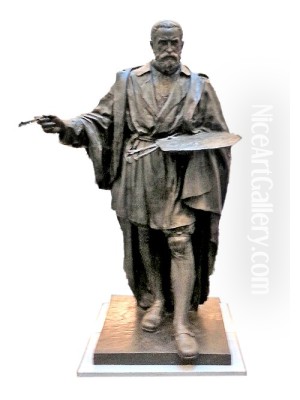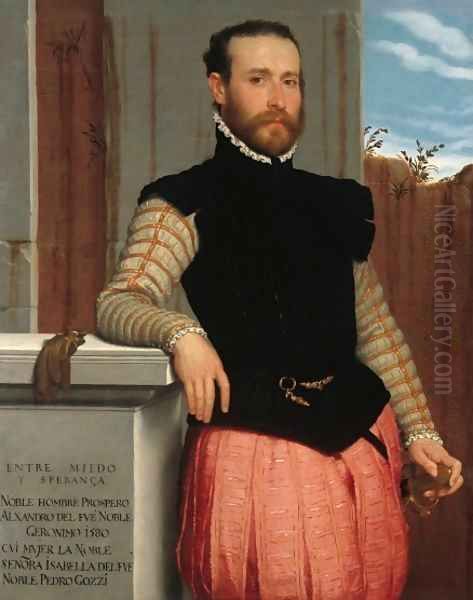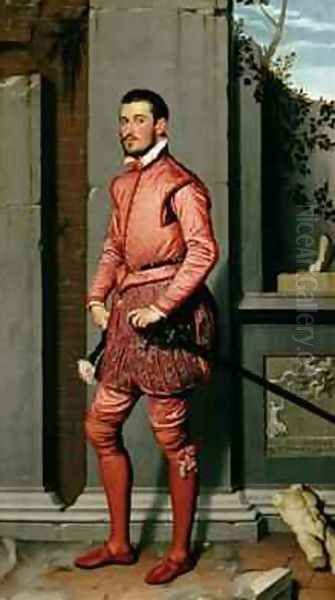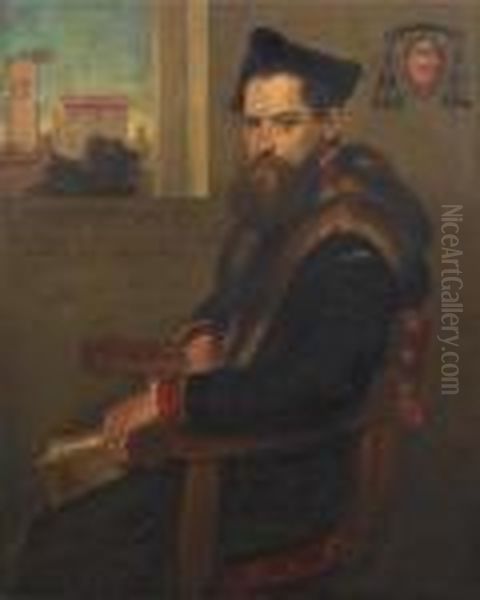
Giovanni Battista Moroni stands as a pivotal figure in the landscape of 16th-century Italian art, particularly celebrated for his penetrating and remarkably lifelike portraits. Active during the Late Renaissance, Moroni carved a unique niche for himself, diverging from the idealized representations often favored by his contemporaries. Born in Albino, near Bergamo in Northern Italy, around 1520 or 1524, he spent most of his prolific career capturing the likenesses and, more importantly, the characters of the local aristocracy, clergy, and professionals. His death on February 5, 1578, marked the end of a career dedicated to a form of naturalism that was both subtle and profound, leaving behind a legacy that continues to resonate in the world of portraiture.
Formative Years and Artistic Roots
Giovanni Battista Moroni's journey into the world of art began in the Lombard region of Italy. He was the son of an architect, Andrea Moroni, suggesting an environment where the principles of design and structure may have been familiar from a young age. However, his path led him to painting, and his formal training took place in Brescia, a significant artistic center in its own right. There, he became a pupil of Alessandro Bonvicino, more famously known as Il Moretto da Brescia.
Il Moretto was a respected painter, known primarily for his religious works, often imbued with a gentle piety and a careful observation of light and texture characteristic of the Lombard school. Under Moretto's guidance, Moroni would have absorbed the fundamentals of painting technique, composition, and the prevailing artistic currents of the region. Moretto's own style, while rooted in High Renaissance ideals, possessed a certain sobriety and realism, particularly in his donor portraits within larger religious scenes, which likely provided a foundational influence for Moroni's later specialization. The artistic environment of Brescia, also home to painters like Girolamo Romanino, fostered a tradition that balanced Venetian colorito with Lombard naturalism, a blend that Moroni would ultimately refine in his own unique manner.
Sojourn in Trento: Faith and Patronage

A significant period in Moroni's early to mid-career involved time spent in Trento. This was not merely a geographical relocation but placed him at the heart of one of the most crucial events of the 16th century: the Council of Trent (1545-1563). This ecumenical council was the Catholic Church's response to the Protestant Reformation, and its decrees profoundly impacted religious art, emphasizing clarity, realism, and emotional directness to inspire piety. Moroni's presence in Trento during parts of this period inevitably shaped his work.
During his time there, Moroni undertook important commissions, including religious subjects. He painted altarpieces and devotional images, such as a notable Last Supper completed later in his career (1569), which reflect the Counter-Reformation's call for accessible and doctrinally sound imagery. While competent, his religious paintings are often described as somewhat more reserved or "heavier" compared to the vibrant immediacy of his portraits.
Trento also offered significant patronage opportunities. Moroni established connections with the powerful Madruzzo family, who were influential figures in the Council and the region. He painted portraits of members of this family, solidifying his reputation as a skilled portraitist. It was also during this period that Moroni's path may have crossed with the towering figure of Venetian art, Titian (Tiziano Vecellio). Some accounts suggest Moroni might have worked for or assisted Titian, who also received commissions related to the Council. Anecdotally, it's suggested that Titian's inability to fulfill certain portrait commissions in the region opened doors for Moroni, allowing him to capture a clientele eager for likenesses. While the exact nature of their interaction remains debated, the comparison highlights Moroni's growing stature.
The Bergamo Portraits: A Study in Naturalism
Following his time in Trento, Moroni returned to the region of Bergamo, which became the primary theater for his artistic activity and where he produced the body of work for which he is most renowned. He established himself as the portraitist of choice for the local elite – the nobility, wealthy merchants, clergymen, and professionals who populated the thriving towns of Lombardy. It was here that his distinctive style truly flourished.
Moroni's approach to portraiture was revolutionary in its commitment to naturalism and psychological insight. Unlike many contemporaries who might idealize their sitters according to classical or courtly conventions, Moroni focused on capturing a truthful likeness, replete with individual characteristics and a sense of presence. His portraits are often described as "speaking likenesses," conveying not just the physical appearance but also the perceived personality and social standing of the subject.

His technique involved meticulous attention to detail, rendering textures of fabric – silks, velvets, furs, simple wool – with palpable realism. He employed a generally cool and restrained palette, often favoring silvery grays, blacks, and subtle earth tones, which allowed the sitter's face and hands, rendered with delicate brushwork, to command attention. His compositions were typically straightforward, often featuring full-length or three-quarter length figures against neutral, uncluttered backgrounds, further emphasizing the individual. He masterfully manipulated light, often using a clear, revealing light source to model form and enhance the sense of immediacy, though generally avoiding the dramatic extremes of chiaroscuro seen later in the Baroque.
Signature Works: Capturing Individuality
Moroni's oeuvre includes numerous masterpieces that exemplify his unique approach to portraiture. Among the most celebrated is The Tailor (Il Sarto), housed in the National Gallery, London. This work is remarkable for its time because it depicts an artisan, not a nobleman or high-ranking cleric, with such dignity and psychological presence. The tailor pauses in his work, shears in hand, looking directly at the viewer with a calm, intelligent gaze. The painting is a testament to Moroni's ability to convey character and status through subtle observation and realistic rendering, elevating a subject from everyday life.
Another compelling work often cited is the Portrait of a Gentleman in Pink (sometimes referred to descriptively, like the snippet's "Gentleman Pointing to a Flame," though the specific identity and symbolism can be debated). Such portraits showcase Moroni's skill in capturing the elegance of his aristocratic sitters while grounding them in a tangible reality. The depiction of luxurious fabrics, the confident yet introspective poses, and the direct engagement with the viewer are hallmarks of his style.
His portraits of women, such as the Portrait of Lucrezia Vertova Agliardi, demonstrate a similar sensitivity. He captured the specific features and bearing of his female sitters, conveying their social position through dress and jewelry, but always retaining a sense of individual personality beneath the formal presentation. Likewise, portraits like that of Prospero Alessandri reveal his consistent ability to render male subjects with a blend of formality and inner life. Whether depicting stern clerics, thoughtful scholars, or proud members of the local gentry, Moroni approached each subject with an eye for truthfulness.
Artistic Dialogue: Influences and Contemporaries
Moroni's artistic development was shaped by his training and the broader artistic context of Northern Italy. The foundational influence of his teacher, Il Moretto, is evident in the careful rendering, sober palette, and realistic tendencies found in Moroni's work. Both artists shared a Lombard sensibility distinct from the more opulent Venetian school.

Another significant influence often noted is that of Lorenzo Lotto, a Venetian painter who spent considerable time working in Bergamo earlier in the 16th century. Lotto was known for his psychologically complex portraits, often imbued with symbolism and a certain nervous energy. While Moroni's style is generally calmer and more objective than Lotto's, he likely absorbed lessons from Lotto's penetrating character studies and his ability to convey the inner state of his sitters.
Moroni's work inevitably invites comparison with the Venetian giant, Titian. While Titian's portraits often project an air of power, status, and idealized grandeur, Moroni's strength lay in his direct, unvarnished realism and psychological acuity. He offered a different kind of insight, less about projecting an official persona and more about revealing the individual. His contemporaries in Venice, such as Tintoretto, Veronese, and the Bassano family, were exploring dynamic compositions, dramatic lighting, and rich color on a grand scale, particularly in narrative and religious painting. Moroni's quieter, more focused naturalism set him apart. Within Lombardy itself, painters like Sofonisba Anguissola were also gaining renown for their insightful portraiture, indicating a regional interest in realistic representation that Moroni masterfully embodied.
Later Years and Recognition
Towards the end of his life, Moroni spent more time back in his native Albino. He continued to paint, producing both portraits and religious works, perhaps entering a more introspective phase. Despite his success and reputation within Lombardy, Moroni did not achieve widespread, pan-Italian fame during his lifetime. A significant factor contributing to this relative obscurity was his omission from Giorgio Vasari's influential book, Lives of the Most Excellent Painters, Sculptors, and Architects.
Vasari, whose work became the cornerstone of Italian art history for centuries, primarily focused on artists from Florence and Rome, and his travels did not extend to a thorough survey of Bergamo and Brescia. Consequently, Moroni, despite his exceptional talent, was overlooked in this seminal text. This lack of inclusion meant that his name and achievements were not disseminated as widely as those of artists championed by Vasari. His reputation remained largely regional, appreciated by those who commissioned and lived with his works but less known in the major art centers to the south.
A Posthumous Renaissance: Rediscovery and Enduring Impact
The true measure of Moroni's significance began to emerge centuries after his death, particularly during the 19th century. It was then that connoisseurs, collectors, and critics, especially in Britain, started to recognize the exceptional quality and unique realism of his portraits. His works began to be acquired by major collectors and eventually entered public collections. Initially, some of his paintings were even misattributed to more famous names like Titian, a testament to their high quality but also indicative of Moroni's previous under-recognition.
As art historical scholarship developed, Moroni's distinct artistic personality was clarified, and his contribution was properly assessed. Critics came to admire his straightforwardness, his psychological depth, and his technical skill. He was lauded for his ability to capture the essence of his sitters without flattery or excessive rhetoric. His influence, though perhaps subtle, can be traced in later Lombard painting, notably in the work of Fra Galgario in the 18th century, who also specialized in realistic portraiture. Some art historians also see echoes of Moroni's naturalism in the development of Venetian genre painting through artists like Pietro Longhi.
Furthermore, Moroni's commitment to objective representation positions him as a precursor to later masters of realism. While direct influence is unlikely, his work shares a certain affinity with the unidealized, psychologically penetrating portraits of artists like the Spanish master Diego Velázquez. Moroni demonstrated that profound artistry could be found in the truthful depiction of individuals, a lesson that resonates across different eras of art history.
Moroni's Place in Art History
Giovanni Battista Moroni occupies a crucial and distinct place in the narrative of 16th-century Italian art. As a portraitist, he was arguably unsurpassed in his ability to combine meticulous realism with deep psychological insight during his time. Working somewhat outside the dominant artistic currents of Venice and Central Italy, he developed a style characterized by its honesty, sobriety, and focus on the individual character of his sitters.
His rejection of overt idealization in favor of naturalistic representation marked a significant step in the evolution of portraiture. He provided a compelling visual record of the society of Bergamo and Lombardy during a period of significant religious and social change. His legacy lies not only in the technical brilliance of his paintings – the subtle handling of light, the masterful rendering of textures, the restrained yet effective compositions – but also in the humanity he conveyed.
Today, Moroni's works are prized possessions of major museums worldwide, including the National Gallery in London, the National Gallery of Art in Washington D.C., the Uffizi Gallery in Florence, and the Kunsthistorisches Museum in Vienna, among others. His rediscovery cemented his reputation as one of the truly great portrait painters of the Italian Renaissance, a master whose quiet realism continues to engage and fascinate viewers with its timeless portrayal of individual identity.